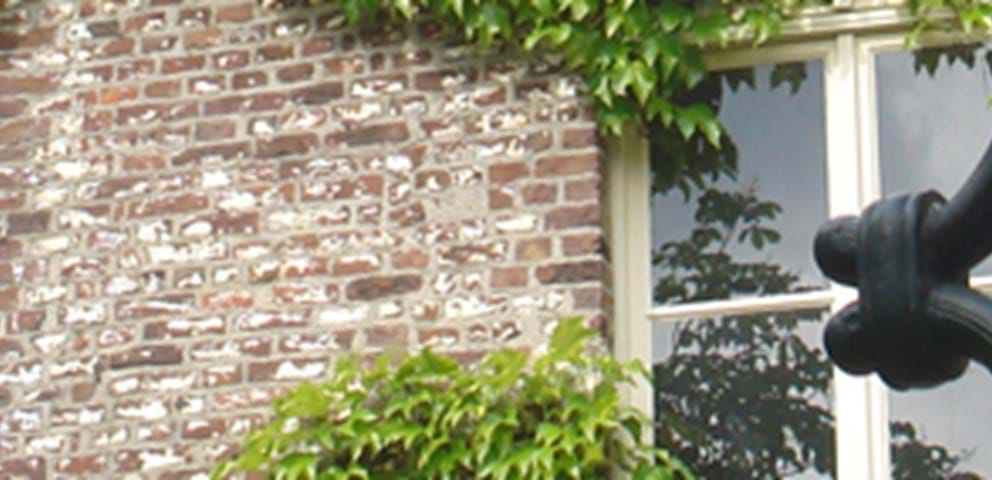
24 gardens with a story
In the old city centre, you will find a great many gardens, parks, and courtyards that are open to the public; these are frequently seen but much less frequently recognized for the lost and forgotten treasures they are. Together, they make up a rich and living tapestry of the history of the city. They tell us a story.
The Ursuline Garden, for example, was originally a part of the city's defensive works, but also tells the story of the Ursuline sisters who established themselves here in 1843. And a portion of this garden also stands testament to the brutal murder of the Jews in our region during the Second World War.
The Jardin des Roses draws the connection between St. Rose, the Virgin Mary (rose without thorns), and Toon Hermans' famous song '24 Roses'.
Fort Sanderbout also tells a story: one of war and peace. For centuries, this was also the Jewish cemetery.
The park known as the 'Firing Range' tells the story of war and destruction, but also of peace and reconstruction, of ancient public gardens, bleaching fields, of lovers, of water and the struggle against it.
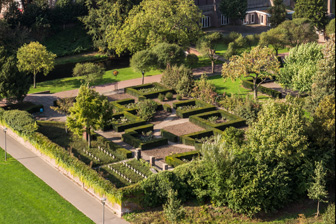
The St. Rose's Chapel tells the story of St. Rose, of the plague, dysentery, and the legend of the Goat Riders, who on this spot, according to legend, swore their godless oath on a severed hand. These and countless other stories run like veins through the ‘green’ history of the city.
Secret gardens
Viewings
The gardens are open for accompanied viewings on the first Saturday of every month. Departure from Jardin d’Isabelle at 11:30 AM. Viewings last until 1:15 PM. Admission is free.
Jardin d’Isabelle
Across from the Cour Solanus, there is a garden forever associated with a sad love story. Charles Beltjens came from a long line of merchants, but as he grew up in the mid-19th century he didn't see his future in trade. Instead, he followed his poet's heart. In the garden of Dr De Borman, he found his muse: the good doctor's daughter, Isabelle. The doctor, however, found him completely unsuitable and forbade their courtship. Charles went to Paris, where he became famous, took in with Victor Hugo and Nobel Prize winner Sully Prud’homme, and was even admitted as a member of the renown Académie Lamartine. When he later returned to Sittard, he was, for the most part, regarded as an eccentric figure, and the children in the town referred to him ever after as ‘Rinaldo Rinaldini.’ As so often happens, immediately after his death he was recognized as a genius and very quickly proposed for a statue in his honour. But it would be a hundred years before that statue became a reality. Today it stands in the Jardin d’Isabelle. Entitled Le Condor Captif (the captive Condor), it is a representation of his impossible love.
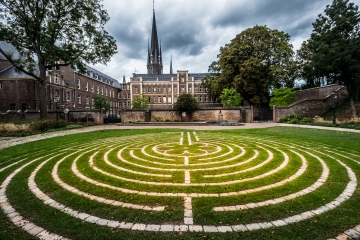
Jardin des Roses
On Paardestraat you will find the very first Toon Hermans House, a centre for cancer patients and their loved ones run by the foundation that bears his name. Toon Hermans opened the centre in honour of his wife Rietje, who also succumbed to cancer. Immediately adjacent to the centre is the Jardin des Roses, with a number of memorials to Toon himself. For many, his songs like ‘24 Roses’ stand as an eternal monument of love.
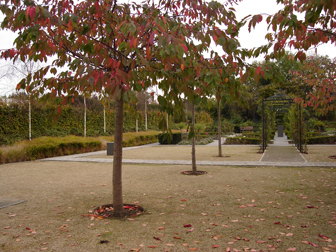
Ursuline garden/City garden
The city garden was created in 1993 in the former gardens of the monastery and boarding school of the Ursuline Sisters. The garden is, at its heart, the garden of the Ursuline Sisters, who established themselves in the 'House on the Hill' on the Old Market Square, and had their garden outside the city wall. The gardens are in the city's former firing range. In addition to the Ursuline Sisters cemetery, the city garden also contains the monument to the murdered Jews of Sittard and the region. The garden includes a section of the city canal, a few rose beds, a row of pear trees, and a playground. At the time of the restoration of the Monastery Quarter, which includes the former convent and boarding school, the old passage through the wall was also restored.
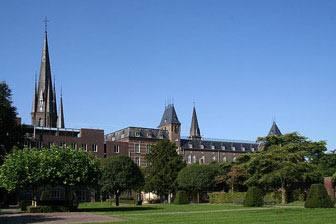
City wall
Sittard's city wall is many centuries old. It almost certainly contains a large quantity of the old city walls built shortly before or around 1300. Its sides were later covered with earth to better absorb the impact of cannon fire. The embankment has been immortalized in poem and song by many, like Thur Laudy, Jo Erens, and Toon Hermans, to name just a few. It has been planted with linden trees since time immemorial; the oldest you can find today are some 200 years old. These have made it long a beloved path for romantic strolls. From the top the embankment, you have a fine view of the old firing range and the centuries-old allotments. Sometimes, you come across unusual and very rare plants in the walls of the embankment.
At the bottom of the embankment at the Begijnenhof, you find the statue of Zefke Mols, Limburg's most famous vagrant and colourful character, who died in 1955. He was a cigar salesman by trade, mainly in Germany, where he was wrongly accused of murder and spent years in prison.
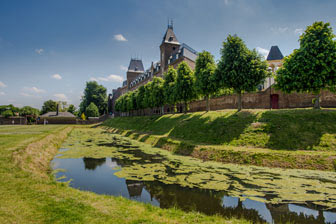
Once released, he wandered through Europe, ultimately returning to Sittard where he became quite a well-known figure.He owned nothing, but lived off the kindness of the city and its people, who gave him food and places to sleep. He was deeply loved in all his simplicity. When he died, he was given a grand funeral attended by all strata of society. He was immortalized in a song by troubadour Jo Erens and in the statue by Gène Eggen.
Fort Sanderbout
Fort Sanderbout, presumably dating from the 15th or 16th century, was set aside for use as the cemetery for the growing Jewish community shortly after the devastation of 1677, when Sittard gave up its pretensions to being a fortified city and instead became an ‘open city’. And so it remained until 1840, when a new cemetery was established. For reasons that remain unknown, in 1965 the cemetery was cleared, in violation of all Jewish custom (but yet with the similarly unexplained consent of the community).
Since then, it has been an open field that was used initially as a playground, but has long fallen into use as an illegal dog park. This spot should once again serve as a place of Jewish history, especially because all synagogues that were ever here have likewise disappeared. The precise locations of the former Jewish graves are known.
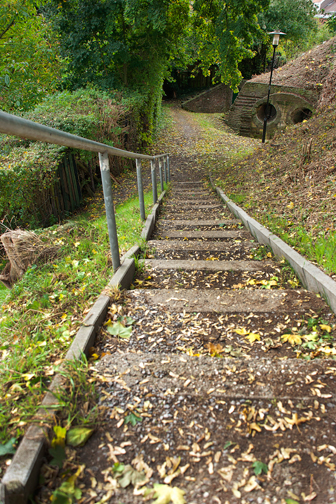
Allotments along the embankment
The Sittard firing range has not served a military function since the city was partially sacked and burned in 1677, at which time the defensive works were largely destroyed. Since then, unique green structures have emerged here, like the allotments through which paths now centuries old, run, wreathed in native shrubs like hawthorn and the rare Cornus mas. At many places, the firing range has been used in the past century as road or parking space, and a few buildings have even been put up on it (like Engelenkampstraat or de Wieër, for example). A fairly large section of it is the Oda parking facility, on top of which modern green structures have now appeared again. The allotments along ‘de Gats,’ however, has been in use as ‘city gardens’ at least since the last quarter of the 17th century, making them a piece of cultural heritage - definitely for our country, and probably for Europe as well.
Gruuzehaöfke
Right in the middle of the city, residents of the apartments in Gruizenstraat have turned a vacant lot in front of their building into a public garden where all are welcome to come and abide. There were once apartments on this lot, but they were demolished forty years ago.
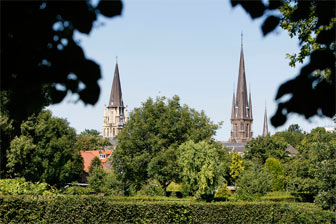
Jo Erensplantsoen, Tempelplein
Jo (Jochem) Erens only reached the age of 28, but 60 years after his death he is still known as Limburg's greatest troubadour. Some of his unforgettable tunes were Zitterd Allein (also known as Limburg Alone), Zefke Mols and Sjwerbelke. He died in 1955 from a brain haemorrhage while studying at the conservatory of classical music.
Plantsoen Gruizenstraat
In a small public garden at Gruizenstraat, near the idyllic Protestant church, a statue was placed in 1975 to honour the many troubadours from our region. Along with Jo Erens, they included Frits Rademacher, Hermans Veugelers, and Chel Savelkoul. Later, new troubadours were added, like Anja Bovendeaard. They, too, were honoured, but more than that, encouraged to make the world a better place with their music and lyrics.
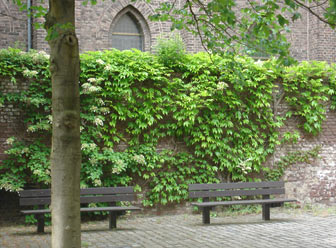
Panelling in St. Michael's Church/Paterskerk
It's a bit of a curiosity, but an element of extraordinary value. The Paterskerk was built by the Dominicans shortly after the middle of the 17th century. At the end of the 17th century, an imposing panel was added in the church depicting the exotic plants, fruit, and vegetables from foreign lands, particularly South America. They are not particularly prominent, but upon closer inspection it is clear that they are tiny works of woodcutting art that must be considered extraordinary examples of the fine wood engraving of the day. Not real life, but definitely lifelike and truly secret to many.
Mariapark Pilgrimage Garden
In 1867, a miracle took place in Sittard that saved the life of one of the boarding students of the Ursuline Sisters. The miracle was attributed to Our Lady of the Sacred Heart. The place quickly became a place of pilgrimage, and an explosion of devotion the likes of which have never been seen in the Netherlands before or since followed. By 1890, over a million people were members of the archconfraternity of the Holy Family. To accommodate the mass influx of pilgrims, a cloister with inner courtyard was built opposite to the church of pilgrimage (which some years before had been made the Netherlands' first Basilica. In the Mariapark, as the cloister came to be called, pilgrims could gather to attend the services in the church. The huge, all stained-glass windows made it effectively a great garden of the church.

Monastery garden and inner courtyard at Agnetenberg
For over a century and a half, the elderly have been received and cared for at the monastery of Agnetenberg. An oasis arose in the great garden behind the monastery. This green space was originally part of the city's defensive works. The rustic 17th-century inner courtyard is a treat for the eye and a balsam for the soul.
Public cemetery
By virtue of its location and purpose, the cemetery is a natural place for reflection, and a number of people extremely important to the history of the city of Sittard are buried in it. Here you will find famous troubadour Jo Erens, well-known city vagrant Zefke Mols, and Sittard's most famous son, Toon Hermans. You will also find a relic of deacon Louis Tijssen, currently under consideration for canonization, still in the grave in which he rested until he was respectfully reinterred in St. Peter's Church. War and peace are depicted in the imposing headstone of resistance fighter Zef ‘The White’ Ronden, alongside the crosses of numerous soldiers.
Prayer stations
For several hundred years, the seven prayer stations at the top of the hill of Kolleberg have been the place where people prayed before setting out for St. Rose's Chapel. About a hundred years ago, the stations were renovated with sponsorship from the residents of Sittard.
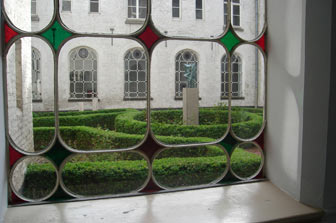
Gemmakapel and Gemmahofke
Just outside the city centre, on Leyenbroekerweg, you will find the former monastery complex of the Passonists. The chapel is dedicated to Saint Gemma Galgani. Fortunately the chapel, from which Toon Hermans (a devoted follower of St. Gemma ten Grave) was borne at his funeral is still in use as a centre of silence and prayer. A number of houses have been built in the old monastery garden in a modest and restrained manner, almost in the style of Beguine houses. The garden has a number of trees that, after blooming, drop seeds that were (and still are) used as pearls for the rose wreath.
Levetenhöfke
The Olive Courtyard (levetenhöfke) dates from the end of the nineteenth century. Halfway up the Kolleberg, it was a place for prayer, to reflect on the depiction here of the Christ's inner turmoil before entering on the physical ordeal of the Passion.
Chapel of St. Rosa
In 1668, Sittard and the region was gripped by a major outbreak of dysentery. The inhabitants of the city prayed to Saint Rose (then only recently canonized as the first saint from South America), and after the epidemic lifted, they made her patron saint of the city. This makes Sittard unique, as the first place in the world to bestow this honour upon her. It was only later that she became patron saint of Lima, of Peru, and of all South America. In 1675, a chapel was built to her on the Kolleberg, and since then there has been an annual procession to it. It was also a central feature in legends relating to the band of Goat Riders who plagued the region, plundering, burning, and murdering, in the 18th century. The oath of the Goat Riders was sworn over a severed hand in the chapel.
Kolleberg Memory Forest
In 1999, a Memory Forest was established atop the Kolleberg. Here, you can plant a sponsored tree in memory of departed loved ones. The forest has become a place where many come to reflect as they travel their road in life.

City Park, with Bergerhof and Ophovenerhof
The City Park was designed as a ‘total concept’ by architect Dirk Tersteeg. It was built between existing historic structures like the originally 13th-18th century Ophovenerhof and mill, the 17th century Stone Lock and the 15th-17th century Bergerhof estate. About a hundred years ago, a number of extraordinary trees were planted in the park. The park also contains an old well (St. John's Well), the waters of which were once thought to have healing powers. At Ophovenerhof, you will find an old farm garden maintained by clients of the care home farm. Often, a market stall on the terrace here sells locally grown regional products.
Krombroodberg
Sand was mined from the Kolleberg for hundreds of years, leaving mining scars across large sections of the slope. Now, nearly a hundred years after the mining stopped, Nature has reclaimed her own and Kolleberg is one of the most beautiful and peaceful places in the city and the region. The segment of the Pieterpad walking route that passes here can rightly be called one of the most beautiful sections of the 485-km path. Two-thirds of the way up the slope, just off to the left, you can still see a very visible remnant of a sand quarry. Today it is known as the Krombroodjesberg, named after the white crescent-shaped breads traditionally thrown to the young people in Sittard on Laetare Sunday in Lent. This local custom has been with us since at least the 16th century, and comes to us from the bible story of the miracle of the loaves and fishes. Traditionally, on this day the poor and children are given gifts of these fine white breads. Opposite the Krombrootjesberg lies the hidden and mysterious meadow where each year hundreds of children have an unforgettable summer holiday doing a variety of outdoor projects.
Frans Klooster
In 1903, a small group of the Sisters of the Divine Providence came to Sittard to start a hospital. That hospital ultimately became Orbis Medical Centre. Though the former Maasland Hospital has since been demolished, the building that started it all still stands, as a monument to charity at the original location on Walramstraat in Sittard. Known as the ‘French Cloister,’ it has a small garden with a standing cross as a symbol of sacrifice.
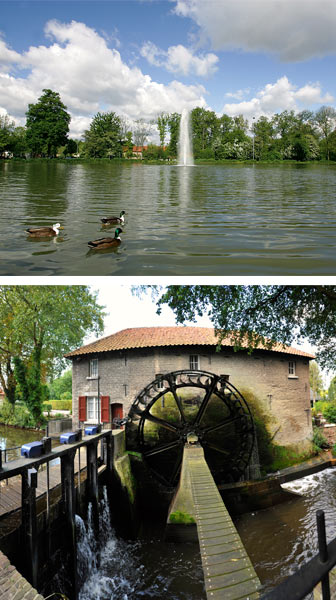
Duustergats
Following the Duustergats from St. Rose's Chapel to the cemetery, at approximately the midpoint of your journey you pass the spot where an American plane crashed during the war. A monument in the Duustergats commemorates the pilot, who did not survive.
Protestant cemetery
Sittard had a Protestant parish very early on, because the Dukes of Jülich had a policy of tolerance towards both Protestants and Jews. Not long after 1600, the Protestants had a cemetery here, and that cemetery is still in use. At this small oasis of silence, you can find gravestones going back 400 years, including a few of significant historical interest. For example, there are very few Protestant cemeteries with depictions of angels, and nowhere but here will you find one inscribed with remembrances of Lourdes…
More on the secret gardens